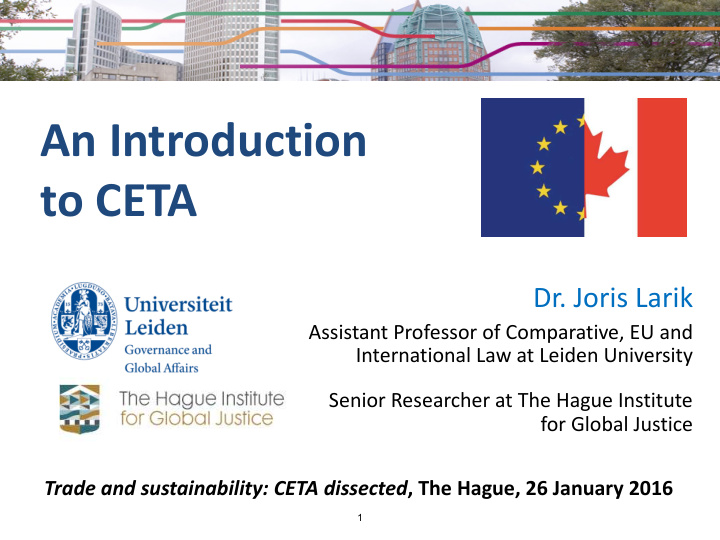



An Introduction to CETA Dr. Joris Larik Assistant Professor of Comparative, EU and International Law at Leiden University Senior Researcher at The Hague Institute for Global Justice Trade and sustainability: CETA dissected , The Hague, 26 January 2016 1
Selected publications: J. Larik, ‘Critiquing TTIP: Systemic Consequences for Global Governance and the Rule of Law’, Legal Issues of Economic Integration , Vol. 43, No. 4 (2016), pp. 423-436 J. Larik, Foreign Policy Objectives in European Constitutional Law (Oxford: Oxford University Press, 2016) J. Larik, ‘Die Unionstreue in der gemeinsamen Handelspolitik: Harmonielehre in einer sich wandelnden Klanglandschaft’, in: C. Herrmann and M. Bungenberg (eds.), Die gemeinsame Handelspolitik der Europäischen Union fünf Jahre nach Lissabon – Quo Vadis? (Baden-Baden: Nomos, 2016), pp. 45-69 J. Larik, ‘Much More Than Trade: The Common Commercial Policy in a Global Context’, in: M. Evans and P. Koutrakos (eds.), Beyond the Established Legal Orders: Policy Interconnections Between the EU and the Rest of the World (Oxford: Hart Publishing 2011), pp. 13-45
Structure 1. Introduction 2. CETA’s history 3. CETA’s final content 4. Two perspectives on CETA 5. CETA and “Brexit” 6. Conclusion and outlook
1. Introduction CETA in context: Deadlocked Doha Round • EU’s normative trade agenda • Civil society criticism of FTAs • Need to “reset” trade policy • (Minister Ploumen) U.S. elections and withdrawal • from TPP Fate of TTIP? • Fate of NAFTA? • 4
1. Introduction (cont’d) Treaty on European Union, Article 3(5): In its relations with the wider world, the Union shall uphold and promote its values and interests and contribute to the protection of its citizens. It shall contribute to […] the sustainable development of the Earth, […] free and fair trade, […]as well as to the strict observance and the development of international law, including respect for the principles of the United Nations Charter. European Commission’s “Trade for all” Strategy (2015): “The Commission will […] promote an ambitious and innovative sustainable development chapter in all trade and investment agreements.” Global Strategy for the European Union’s Foreign And Security Policy (2016) “We will use our trade agreements to underpin sustainable development, human rights protection and rules based governance.” 5
6
2. CETA’s history May 2009: Launch of negotiations • Aug. 2014: Main negotiations • concluded July 2016: CETA declared “mixed” • for political reasons Oct. 2016: “Wallonia crisis” • 27 Oct. 2016: Joint Interpretative • Instrument 7
2. CETA’s history (cont’d) 30 Oct. 2016: Approved and signed by EU • and Canada Pending ratification by Canada, EU and • Member States before entry into force Dec. 2016: CJEU Opinion 2/15 (EU • Singapore FTA), AG Sharpston Opinion à “mixity” legally required 24 Jan. 2017: CETA approved by EP Trade • Committee Possibility to provisionally apply CETA • 8
3. CETA’s final content Substantive coverage: E-commerce • Trade in Goods Competition • • SPS measures Gov’t procurement • • TBT IP • • Subsidies Regulatory Cooperation • • Trade in Services Trade and Sustainable • • Development Investment • Trade and Labour • Transport • Trade and Environment • 9
3. CETA’s final content (cont’d) Institutional provisions: CETA Joint Committee • Further specialized committees, including a Committee on Trade • and Sustainable Development Investor-State Dispute settlement, including an appellate tribunal • Inter-party dispute settlement (one-shot arbitration, does not • apply to “Trade and Labour” and “Trade and Environment” chapters) Expert panels and a civil society forum • 10
Overview of commitment under trade and sustainable development chapters in CETA Laura Puccio and Krisztina Binder, Trade and sustainable development chapters in CETA , European Parliamentary Research Service, Briefing (January 2017) 11
4. Two perspectives on CETA “Devil’s advocate” “Alternative Devil’s advocate” Sustainable development Most vocal FTA about SD yet (incl. • • commitments hortatory precautionary principle) SD contained in chapters to Aspirational provisions require • • which regular dispute legislative and executive action, settlement does not apply multilateral cooperation SD not linked to ISDS clearly ISDS chapter very clear about “right to • • enough regulate” and lack of review powers Mostly run by experts and Joint Interpretive Declaration provides • • gov’t officials “even greater certainty” & possibility of future interpretive statements No sanctions • 12
5. CETA and “Brexit” ! ? ! !
6. Conclusion and Outlook Result of a long negotiation process, including civil society criticisms • and subsequent amendments, providing actual “greater certainty” and (arguably) acceptance Long road ahead for ratification, but provisional application in sight • Vocal commitment to sustainable development, but only • implementation/practice will be “proof of the pudding” Two troublesome disconnections: • Ø Then : Trade negotiators/lawyers vs. civil society Ø Now : Advocates of “comprehensive trade agenda” vs. advocates of “quick trade deals” & “protectionism” 14
Thank you! Contact: j.e.larik@luc.leidenuniv.nl Latest publications: leidenuniv.academia.edu/JorisLarik 15
Recommend
More recommend